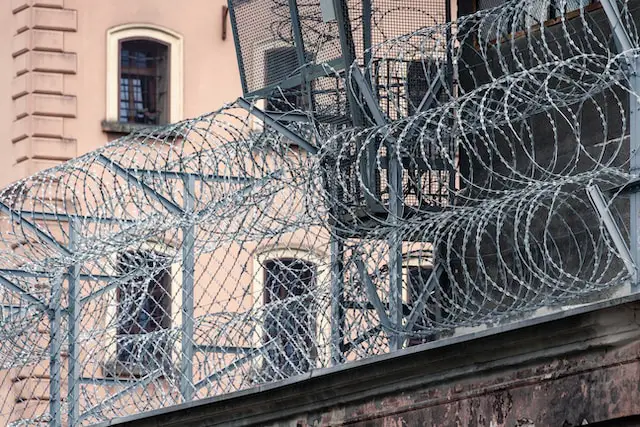Prisons and jails are both facilities that serve to detain individuals who have been convicted of a crime or are awaiting trial. However, there are significant differences between these two types of institutions in terms of the length of stay, conditions, and purpose.
Prisons
(Photo by Pawel Czerwinski on Unsplash )

Prisons are long-term correctional facilities designed to house individuals who have been convicted of serious crimes. In most cases, inmates in prison serve sentences that last for more than a year. Prisons can be operated by various entities such as the federal government, state governments or even private companies.
One of the main goals of prisons is to protect society from dangerous criminals by keeping them confined behind bars. However, they also aim to rehabilitate and reform offenders through educational programs and job training opportunities.
Life inside a prison is highly regimented with strict schedules for meals, work assignments, and recreation time. Inmates typically live in communal housing units and must follow strict rules governing their behavior while inside the facility.
Despite efforts at rehabilitation, life in prison can be challenging both mentally and physically for inmates. They may experience feelings of isolation or depression due to being separated from loved ones for extended periods of time.
Prisons play an essential role in our criminal justice system by helping to keep dangerous individuals off the streets while offering opportunities for rehabilitation and reform.
Jails
(Photo by Grant Durr on Unsplash )

Jails are detention centers that hold individuals who have been accused of committing a crime and are awaiting trial or sentencing. Typically, jails house inmates who have been sentenced to less than one year in prison. Jails are often run by local authorities such as counties or cities.
Unlike prisons, which usually house convicted felons serving long-term sentences, jails serve a different purpose. They act as temporary holding facilities for those awaiting their court dates or transfer to other correctional facilities.
Due to the fact that inmates in jail are still awaiting trial or sentencing, they may not have access to certain programs and services offered in prisons such as educational opportunities or work release programs. Additionally, because jail stays tend to be shorter than prison terms, there is often less emphasis on rehabilitation and more focus on maintaining order within the facility.
While both prisons and jails serve important roles within the criminal justice system, it’s important to understand the differences between them in order to better understand how our justice system operates.
Prisons Vs. Jails – Key differences
Prisons and jails are often used interchangeably, but they are not the same thing. Prisons are long-term facilities where individuals convicted of crimes serve sentences longer than one year. Jails, on the other hand, are short-term holding facilities for individuals awaiting trial or serving shorter sentences.
Another key difference between prisons and jails is their operating authority. Prisons fall under state or federal jurisdiction and tend to be operated by government agencies. Jails, however, can be run by local law enforcement agencies such as county sheriffs’ offices.
Conditions in prisons and jails also differ significantly. Prisons generally have more extensive resources for inmates such as educational programs and vocational training opportunities compared to jails that may offer limited rehabilitation services.
Length of stay differs between prisons and jails with inmates spending years in prison while jail stays range from a few days to one year at most.
Understanding these differences helps ensure that appropriate terminology is used when discussing correctional facilities depending on whether it is focused on long-term incarceration or short-term detention before trial or sentencing.
Length of stay in prisons and jails
The length of stay in prisons and jails is one of the most significant differences between both institutions. In general, people who are sentenced to prison have been convicted of more severe crimes than those who go to jail. Therefore, they tend to face longer sentences.
While the length of a prison sentence can vary from a few years to life imprisonment, inmates often spend several years behind bars before being released. On the other hand, people held in jail typically face shorter sentences that last less than a year.
It’s worth noting that some states may have different laws regarding sentencing lengths for specific offenses or repeat offenders. Additionally, overcrowding and limited resources can influence how long an inmate stays incarcerated.
Understanding the difference in length between prisons and jails is critical for anyone facing criminal charges or working within the justice system. By knowing these distinctions ahead of time, individuals can better prepare themselves mentally and emotionally for their upcoming experience behind bars.
Difference in Conditions in Jails and prisons
Jails and prisons are two different types of correctional facilities that have distinct differences in their conditions. Jails are usually run by local law enforcement agencies, while prisons are operated at a state or federal level.
One major difference between the two is the living conditions for inmates. Jails typically house inmates who are awaiting trial or serving sentences of less than one year, which means they often have shorter stays than those in prison. This also means that jails can be overcrowded, with little to no privacy for the inmates.
On the other hand, prisons offer more long-term housing options for individuals serving longer sentences. They tend to provide better living conditions such as larger cells and access to educational programs, job training opportunities and even healthcare services.
Another major difference between jails and prisons is security levels. Prisons generally have higher levels of security due to the nature of their population- including high-risk offenders with violent histories and long criminal records.
While both institutions aim to rehabilitate their inmate populations through various forms of programming, there exist significant differences between them when it comes to living conditions and security measures provided by each type of facility.
Which is the largest prison in the world?
When it comes to the largest prison in the world, one might assume that it is located in a country with a high crime rate or overpopulated prisons. However, this may not necessarily be true.
The title for the largest prison in the world goes to Kwan-li-so No. 22, also known as Camp 22, which is situated in North Korea. This prison camp was built during the rule of Kim II Sung and used to house political prisoners along with their families.
Camp 22 has been operational since 1965 and covers an area of approximately 770 square miles (2,000 square kilometers). It has been reported that around 50-70 thousand prisoners are currently being held there who have committed crimes against the state.
The conditions at Camp 22 are severe and horrific. Prisoners work long hours under harsh conditions and suffer from malnutrition due to inadequate food supplies. Inmates are subjected to physical torture, medical experimentation without anesthesia or painkillers, forced abortions on pregnant women prisoners and even public executions.
Despite international condemnation of its human rights abuses practices towards its citizens within these camps including Kwan-li-so No. 22; North Korea remains indifferent towards criticism by simply denying such accusations exist – something many human rights organizations refute through satellite imagery taken over these camps providing evidence of mass graves utilized for disposing dead bodies covertly
Featured Image By – Emiliano Bar on Unsplash








